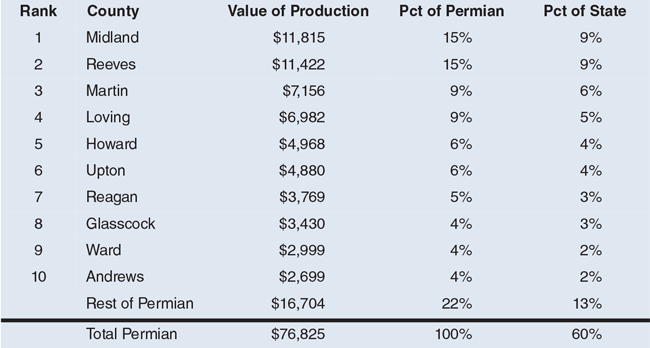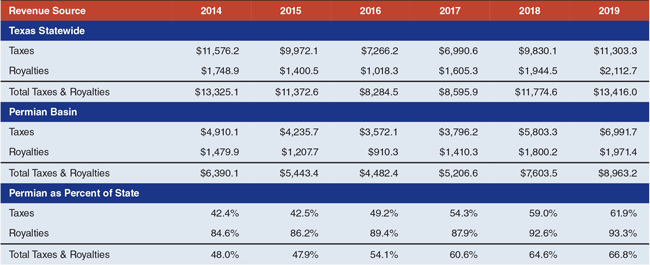
Report Spotlights The Mighty Permian
Although 2020 has brought some unpleasant surprises that have clouded the future even more than normal, the Permian Basin’s massive economic contribution to Texas is abundantly clear, indicates a new Permian Basin Petroleum Association report developed with the Texas Taxpayers & Research Association.
“The year 2020 has brought sudden unexpected challenges to Texas and to the oil and gas industry,” “The Permian Basin: Enriching Texas” acknowledges. “Economic caution from the spread of a new coronavirus, coupled with a massive temporary glut of oil on world markets has put the Texas Miracle on hold, and much of the oil and gas industry with it. The story of Texas oil and gas has yet to be written for 2020. The chapters of the recent past have been about the Permian Basin, as will those of our eventual recovery.”
The study, which reviews the Permian’s oil and gas contributions to Texas state and local finances during the past five years, emphasizes the basin’s recent ascendency. It notes that the Permian comprises 26% of Texas’ land area and 4% of its population, but has become a such a hydrocarbon heavy hitter that, in April 2019, Forbes moved it above Saudi Arabia’s Ghawar oil field as the “World’s Top Oil Producer.”
The report points out the basin’s rich history stretches back to 1920, and notes that the basin’s best days appeared to be behind it by 2005, when fewer than one in five Texas rigs were drilling there.
However, “Enriching Texas” details, the oil and gas industry’s technological innovation revived the Permian by freeing reserves previously deemed uneconomical. From 2014 through 2019, it notes, the region’s transformation was manifest in areas such as:
- Rig count, where in 2014, half the state’s operating rigs were in the Permian, and by 2019, 70% of the state’s rigs were running there;
- Oil production, for which less than half the state’s output came from the Permian in 2014, whereas it grew to more than two-thirds by 2019; and
- Natural gas production, for which the Permian contributed only 17% of Texas’ total in 2014, a figure that would grow to almost 40% in 2019.
Essentially, the report emphasizes, all growth in statewide oil and gas production during the past five years has come from the Permian Basin, which has generated huge sums for Texas coffers. The report breaks that output down among the state’s top 10 Permian producing counties, with Midland, Reeves and Martin counties leading the way (Table 1).
TABLE 1
Texas Top Producing Permian Basin Counties, 2019 Value of Production, Millions of Dollars
Note: The value of production was estimated using oil, gas, and condensate production figures from the Texas Railroad Commission and multiplying that by the average spot price of each product for that state fiscal year. Numbers may not add due to rounding.
“In 2019, Texas oil and gas producers directly contributed a record $13.4 billion to the state treasury in the form of taxes and royalties–just topping the 2014 record of $13.3 billion,” “Enriching Texas” details. “Though the numbers are similar, the components were substantially different. The record in 2014 was largely price driven, while 2019’s record was production driven,” the report notes, observing that crude prices dropped 40% from 2014 to 2019, while Permian production climbed 67%.
$312 Per Texan
Moreover, the analysis adds, in 2014, $6.4 billion, or 48% of that industry-based revenue, originated from the Permian; whereas in 2019, the Permian Basin accounted for $9.0 billion, or 67%, of Texas oil and gas taxes and royalties (Table 2), a sum equal to $312 for every Texan.
“Absent this revenue, the average Texan would either have had to accept a lower amount of services from state and local governments or would have had to pay that much more in taxes,” the report notes. “This ‘Permian Dividend’ may be heavily discounted in 2020. However, even though the industry may be at a pause, it is still at the forefront of the solution to the state’s fiscal challenges. Oil and gas has been the chief source of revenue flowing into Texas’ very robust Economic Stabilization, or ‘Rainy Day Fund,’ and is likely to save Texans from either difficult budget cuts or higher taxes.”
TABLE 2
Texas State and Local Taxes and Public Royalties Paid
Statewide Producers and Permian Producers, Millions of Dollars
Note: Numbers may not add due to rounding.
Source: Calculated by the Texas Taxpayers and Research Association.
Among the figures the study sites to illustrate the Permian’s increasingly prominent place in the Lone Star State’s industry and economy is that one in five of the United States’ major producing fields are found within the Permian, and that the basin accounts for a quarter of U.S. proved crude oil reserves.
Meanwhile, thanks to the state’s substantial land and mineral holdings in the Permian, the report notes output from the basin has funneled considerable sums into Texas public and higher education, with 2019 figures showing Texas collecting 93%–$2.0 billion of $2.1 billion–in mineral royalties from the Permian Basin. Those monies, it points out, are dedicated to Texas’ Permanent University Fund and the Permanent School Fund.
The report acknowledges 2020 market dynamics–such as the Russian-Saudi crude oil price war and transportation fuel freefalls associated with the coronavirus pandemic–have affected both petroleum supply and demand to oil and gas companies’ detriment, but it also points to a lesson of history for context. “Texas is long used to dramatic swings in the oil and gas industry,” the study says. “For all the obituaries written over the years, not one has ever proven true.”
For other great articles about exploration, drilling, completions and production, subscribe to The American Oil & Gas Reporter and bookmark www.aogr.com.
















